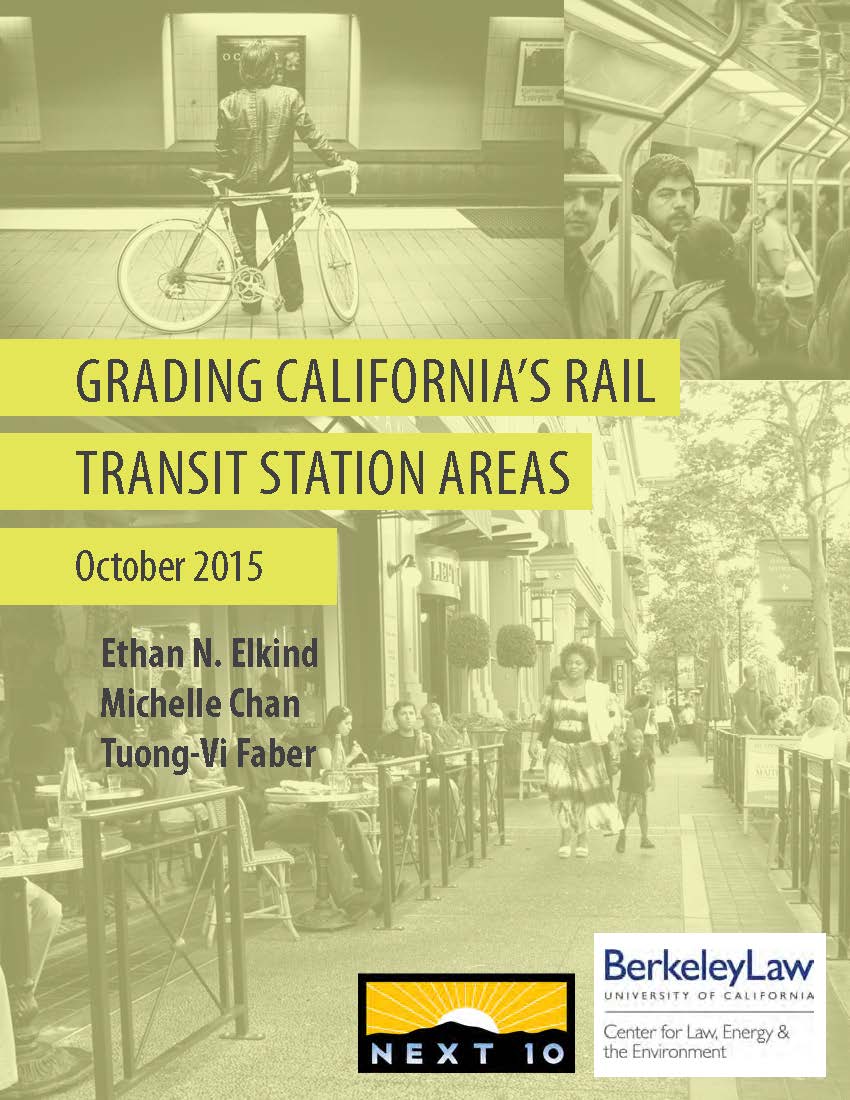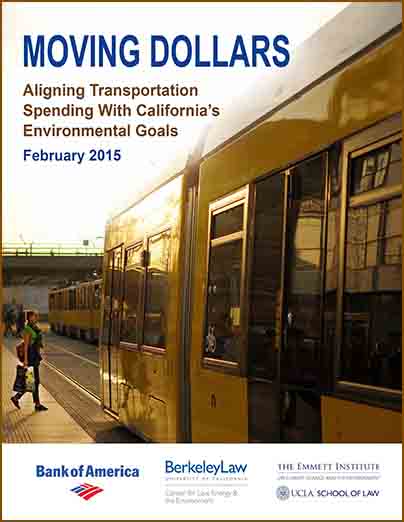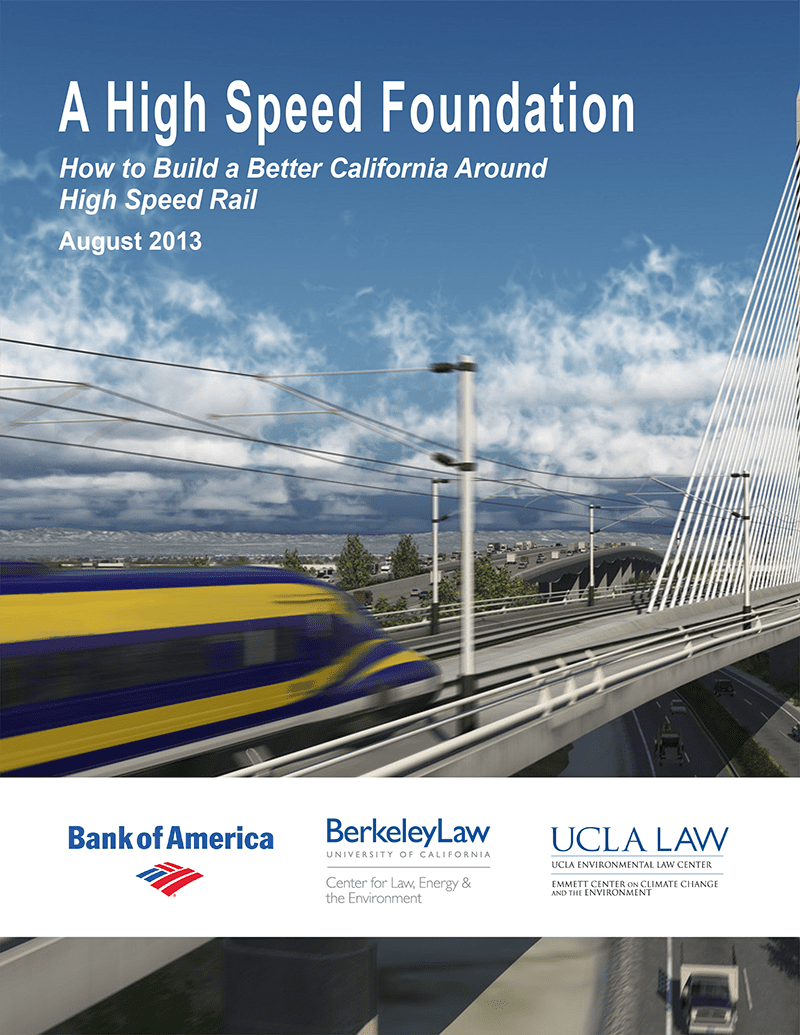Transportation emissions are the number one source of greenhouse gases in California and many other advanced economies. Our reports present options to reduce these emissions, with a focus on reducing the need for driving through enhanced public transit options.
November 2015
Grading California’s Rail Transit Station Areas
Our analysis of California’s rail transit systems discovers which transit  stations serve as hubs of thriving, walkable areas that encourage residents and workers alike to ride the train, and which station areas need improvement. The report divided rail transit station areas into three types: residential, employment, and mixed, and calculated grades based on 11 key indicators including walkability, ridership levels, existing land-use and permitting policies, affordability and transit quality.
stations serve as hubs of thriving, walkable areas that encourage residents and workers alike to ride the train, and which station areas need improvement. The report divided rail transit station areas into three types: residential, employment, and mixed, and calculated grades based on 11 key indicators including walkability, ridership levels, existing land-use and permitting policies, affordability and transit quality.
Key findings: The grades reveal that high-performing stations are often in the middle of transit systems in downtown-like environments, while the poorest-performing stations are often located at the outer edges of the rail systems and the urban areas. Low density, auto-oriented areas, even when graded against similar place types, scored poorly.
Also see our op-ed in the San Diego Union-Tribune.
February 2015
Moving Dollars: Aligning Transportation Spending With California’s Environmental Goals
California’s state, regional and local  governments spend roughly $28 billion each year on transportation, with the majority of the funding for highways and other auto-oriented infrastructure. Yet state laws related to greenhouse gas reduction, more compact real estate development, and multimodal transportation options, such as walking and biking, necessitate reductions in vehicle miles traveled.
governments spend roughly $28 billion each year on transportation, with the majority of the funding for highways and other auto-oriented infrastructure. Yet state laws related to greenhouse gas reduction, more compact real estate development, and multimodal transportation options, such as walking and biking, necessitate reductions in vehicle miles traveled.
Key policy recommendations: State-developed project performance standards to ensure new transportation projects meet various sustainability metrics, a greater percentage of transportation dollars directed to maintenance of existing infrastructure (including “complete streets” options), and improved transparency and decision-making in allocating transportation funds.
This project is part of the Climate Change & Business Research Initiative.
August 2013
A High Speed Foundation: How to Build a Better California Around High Speed Rail
California will soon begin construction of a proposed high speed rail system in the San Joaquin Valley, which will ultimately connect to Los Angeles and San Francisco. If implemented poorly, however, the system could lead to unchecked development in the Valley that could increase traffic, exacerbate the loss of farmland, and generate more air pollution.
Key policy recommendations: a Valley-wide collaborative to create a plan for economic growth and environmental preservation around the high speed rail network, support for local planning and mitigation efforts to implement it, and new financing mechanisms to catalyze private investment in station-connected development.
Also see our webcast presentation featuring Fresno mayor, Ashley Swearengin.
This project is part of the Climate Change & Business Research Initiative.
July 2011
All Aboard: How California Can Increase Investments in Public Transportation
A well-funded and comprehensive public transit system in California could help the state reduce greenhouse gas emissions associated with driving and save residents and businesses time and money.
Key policy recommendations: State policies that lower the threshold for voter approval of transit tax measures, authorization of tax increment financing for transit improvements, better land use surrounding transit stations, and more efficient use of existing transit resources and infrastructure development.
This project is part of the Climate Change & Business Research Initiative.
July 2010
Plan for the Future: How Local Governments Can Help Implement California’s New Land Use and Climate Change Legislation
Many local governments need assistance developing the land use plans necessary to implement SB 375, the state’s landmark law that coordinates transportation and land use planning at the regional level. Key policy recommendations from this report include improved public outreach to encourage citizen participation in developing a vision for population growth and transportation in local communities, expanded financing for local government planning efforts, and streamlined local land use codes and sharing of best practices.
This project is part of the Climate Change & Business Research Initiative.

.jpg)
